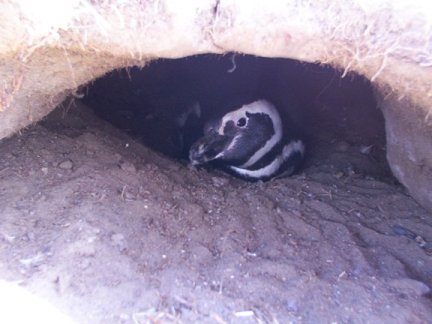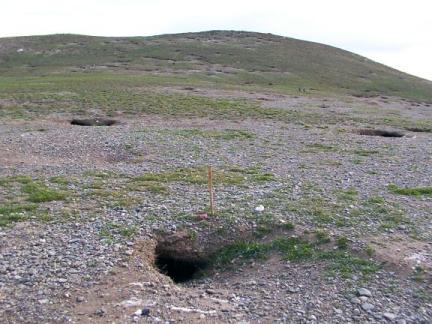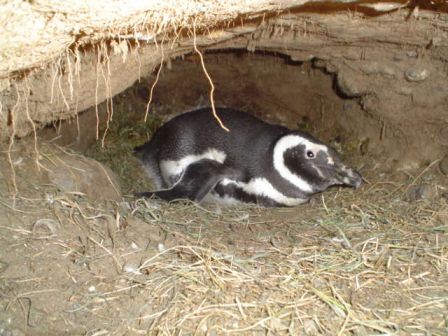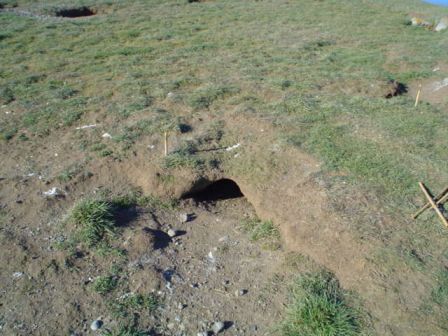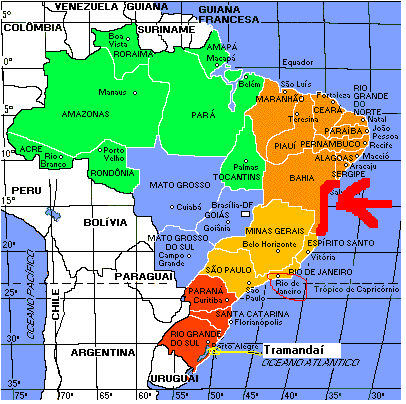MAGELLANIC PENGUIN
(Spheniscus magellanicus)
The Magellanic Penguin is only found around the Falkland Islands and South
America, but it is extremely numerous within these regions. The Falkland
Islands has a population well in excess of 100,000 breeding pairs, but this
is small compared to populations in South America, which number around
1,500,000 breeding pairs. Breeding colonies range from the Golfo San Mat�as
in Argentina, southwards around the islands of Tierra del Fuego, and
northwards up the Pacific coast of Chile as far as Coquimbo.
The Magellanic Penguin is around 70cm long, and has an average weight of
about 4kg. The head and upper parts are black apart from two broad white
stripes beneath the throat; one running up behind the cheeks and above the
eye to join the pinkish gape, the second running adjacent to the white
underparts with which they merge above the legs. Females are slightly
smaller than the males, but have similar plumage.
Penguins of the Genus Spheniscus, to which Magellanic, Humboldt and
Galapagos penguins all belong, are much more loosely colonial than other
penguins. They generally nest in burrows when soil conditions permit, and
are consequently spaced much further apart than surface-nesting penguins.
Magellanic Penguin colonies in particular often extend over several
kilometres of coastline, at densities ranging from 0.001 to 0.1 nests per
sq.m.
Magellanic Penguins are widely distributed throughout the region. They
particularly like offshore islands with tussac grass or small shrubs, which
are in abundance around the Falkland Islands, Tierra del Fuego and the
Pacific coast of Chile. Such islands offer deep layers of soil for burrowing
into, and dense vegetation offering protection from aerial predators. The
Atlantic coast of Argentina is much drier, and has less vegetation cover,
but it is still home to around 650,000 breeding pairs, many of which nest
above ground in surface scrapes or under bushes. Magellanic Penguins prefer
to nest in burrows, but when soil conditions are unsuitable for burrowing,
they will nest on the surface using whatever protection they can find.
Adults arrive at the nest sites to breed in September, and after a period of
burrow excavation and repair, begin egg laying around mid October. Two
equally sized eggs are laid 4 days apart, each with a weight of around 125g.
Incubation takes around 40 days, with the female incubating the eggs for the
first shift, while the male feeds at sea. He forages at distances of up to
500km away from the breeding site, before returning to relieve the female
some 15 or 20 days later. She then goes to sea for a similar period, and
when she returns, the two birds change over at regular intervals until the
eggs hatch.
Both parents continue to brood the chicks in turn on a daily basis, for a
period of about 30 days. Chicks are fed daily, with adults leaving the
colony in early morning, and returning with food later the same day.
Magellanic Penguins mostly forage within 40km of the nest site during this
period, except in the Falklands where foraging is affected by commercial
fishing. Foraging trips become longer as the chicks become larger, and
demand more food, and chicks may then have to wait several days between
meals.
When the weather is fine larger chicks often sit outside their burrow
entrances, but will rapidly return to the safety of their burrows at the
first sign of danger. Fledging occurs at 9 to 17 weeks of age, depending on
food. Fledglings look similar to the adults, except for being greyer and
lacking the clearly defined banding of the adults.
Freedom from parental responsibilities allows the adults to spend a period
of time at sea, feeding up in preparation for their annual moult in March.
Moulting takes 3 to 4 weeks, after which the adults leave the breeding site,
and remain at sea until the following breeding season. Magellanic Penguins
can live to about 20 years of age.
Females may begin breeding at 4 years of age, but the males do not normally
breed until they are at least 5 years old. This is quite possibly a
consequence of there being more males than females, making it easier for
inexperienced females to find partners than for inexperienced males.
Magellanic penguins generally show strong site and mate fidelity, and
pair-bonds are reinforced by allopreening.
Magellanic penguins are opportunistic feeders, taking roughly equal
proportions of fish, squid and crustaceans. During chick-rearing, foraging trips are generally conducted on a daily basis
during daylight hours, except in the Falklands where food is harder to find.
Birds generally forage at depths of less than 50m, but on occasions may dive
up to 100m. Winter foraging for prey often takes them way beyond their
normal breeding range, with birds travelling as far north as Brazil.
Magellanic Penguins declined severely in the Falkland Islands during the
1980's and 1990's, which coincided with the rise of commercial fishing for
squid and finfish. The current Falklands population (2000/01) stands at less
than 30% of its 1990/91 level, and this decline is still continuing. These
declines have not occurred in nearby Chile.
Comparisons of colonies in the Falklands and Chile appear to confirm that
competition with commercial fishing is a major cause of the Falklands
decline. Adult penguins in Chile are able to return with food for their
chicks on a daily basis, with foraging trips averaging 16 to 18 hours. By
contrast adults in the Falkland Islands take approximately 35 hours to find
the same amount of food.
With only half the amount of food being fed to chicks, lower chick survival
rates would be expected, and this is confirmed by research. Over recent
years breeding success and chick survival rates have been substantially
higher in Chile (average 1.35 chicks per nest) than in the Falklands
(average 0.82 chicks per nest). This huge difference in breeding success is
sufficient to account for the gradual decline in population, with
insufficient chicks being reared in the Falklands to replace natural adult
mortality.
An estimated 40,000 Magellanic Penguins are killed by oil pollution every
year along the coast of Argentina, representing the main cause of adult
mortality in this area. The commencement of oil exploration around the
Falkland Islands could mean similar mortality amongst Falkland penguins,
unless considerably higher standards to those employed in Argentina are
demanded. Unfortunately early indications are not good. During a 5 month
period of oil exploration around the Falklands in 1998, no less than three
oil spills occurred, killing several hundred penguins, cormorants and other
seabirds.
Magellanic Penguins from both the Falkland Islands and South America face
natural predators at sea, such as sea lions, leopard seals and orcas (killer
whales). They also face predation of chicks and eggs by avian predators,
such as gulls and skuas, but where the penguins nest in burrows, such
predation is greatly reduced.
Magellanic Penguins are also killed by crab fishermen around the remoter
parts of southern Chile, the penguin carcasses being used to bait their crab
pots. This probably has little impact on the overall population, but
decimates the breeding sites that are affected.
Magellanic Penguins are popular for tourism, but they are the most nervous
of penguins. Visitors that approach breeding sites which do not normally
have many visitors, will send the penguins scurrying into their burrows for
safety. Magellanic Penguins do readily adapt to regular visitation however,
and become much less nervous with time. Nevertheless, careful control of
tourism near Magellanic Penguin burrows needs to be enforced, since burrows
will readily collapse if walked over.
Simple fences keeping people just 2 or 3 metres away from burrows is all
that is required, and this can benefit both penguins and tourists. Not only
are the penguins protected from being crushed in their burrows, but they
also rapidly learn that humans will not enter beyond the fence, and will
confidently remain sitting outside their burrows for all to see. By
contrast, visitors to unfenced sites will generally see little more than
distant penguins scurrying away, or faces looking out from within their
burrows.

